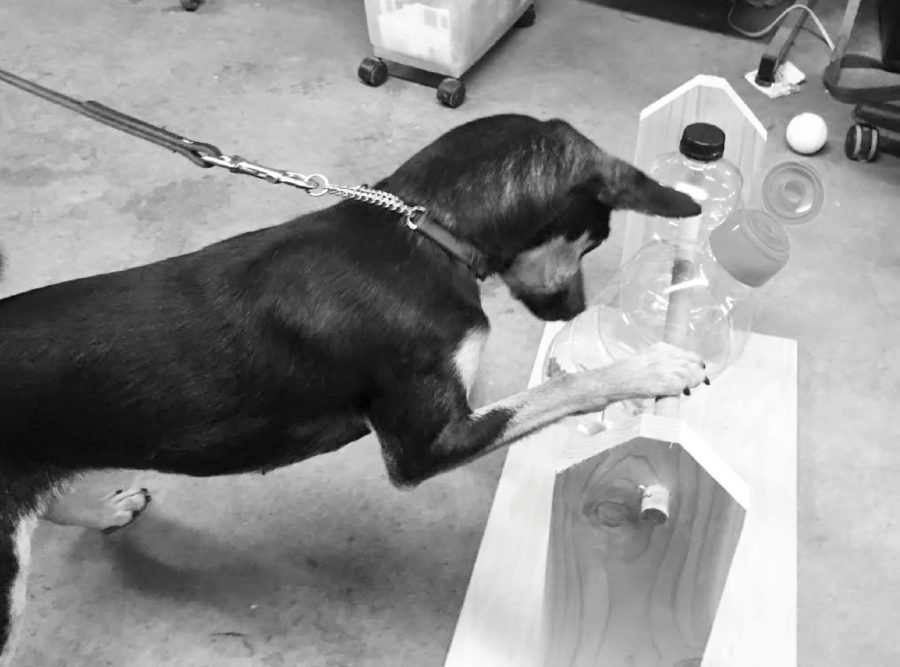Woodworking creates toys, stress outlet for animal shelter dogs
Attempting to get the treats out of the bottle, a Heartland Animal Shelter dog plays with a wooden toy created by Woodworking Instructor Stephen Silca and senior Jeremy McCann. Many dogs at the shelter are able to play with these toys as a way to relieve the stress they face everyday. Photo courtesy of Kara Busiel
February 9, 2018
Living in the environment of an animal shelter can be difficult for dogs, according to Joanne Rowe, Heartland Animal Shelter (HAS) Board of Directors vice president. With the piercing barking and various people constantly coming in and out of the tight living quarters, dogs begin to mentally break down after only two weeks. However, due to the three interactive enrichment wood toys built by Woodworking Instructor Stephen Silca and senior Woods student Jeremy McCann, their well-being has shown great improvement.
The toys, built before winter break, are simple puzzles that are used as mental stimulants for the brain. Silca explained that there are three bottles on a wooden rod with treats inside, and the objective for the dogs is to invert the bottle and get the treats out. Stephanie Muller, HAS executive director, said the shelter reached out to Silca about the toys hoping to use them as stress relievers for the dogs.
“Giving the dogs additional mental stimulation gives them a level of enrichment they don’t have otherwise,” Muller said. “We care for their physical and emotional needs [by going] on walks and [having] playtime, but making them use their minds [will] provide an additional benefit that going on walks doesn’t give them. It’s another way to keep their minds sharp and active because the kennel can be a very stressful environment.”
While Silca aided in the building of the toys, the main work was done by McCann. He chose to volunteer with this project due to his love for dogs and ability to learn about something new.
“Silca proposed [the project] to me and I was on board,” McCann said.“I have a dog myself and [had] never heard of this sort of toy, [as] I didn’t know dogs [could] be stimulated and actually learn. That was pretty interesting [and the toys] were a lot of fun to build.”
Rowe has had the opportunity to see the dogs play with the toys, and has been intrigued watching each dog approach the puzzle.
“[The dogs] tried to chew the bottle and [kept] sniffing the opening knowing there was food,” Rowe said. “They had to work hard because [pushing] too hard would keep the food at the bottom of the bottle as it spun around.”
The ultimate goal of the HAS is to have their animals adopted into welcoming homes, Rowe says. These toys increase the chances of adoption because it gives future pet owners a good first impression of the dogs.
“If I’m showing a dog to a potential adopter and they’re just petting it, I’ll go and grab one of the toys [Silca and McCann] made for us and the dog goes right to it,” Rowe said. “It’s not only letting our dogs release some stress and have some stimulating activities besides sitting in the kennel all day long, but it’s impressive to potential adopters.”
By doing this project, Silca hopes that McCann learned a valuable lesson about the importance of helping those in need.
“When a service opportunity comes along, it’s always cool to save money and help other people by using your skills and materials we have in the shop,” Silca said.
Not only do the dogs love the toys, according to Rowe, but they’ve also had a tremendous impact on the dog’s behavior.
“When we bring a dog [into the shelter], it immediately runs to the puzzle that [Silca and McCann] made for us and they can hardly wait to [play with] it,” Rowe said. “It has provided so much positive reinforcement and mental stimulation for our dogs and we really cannot thank [Silca and McCann] enough for choosing this particular project.”



